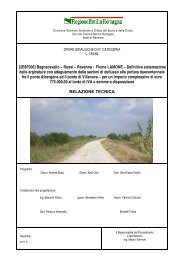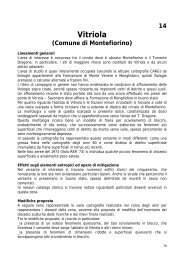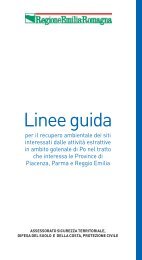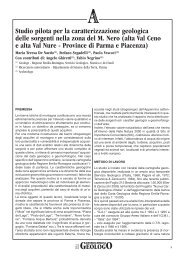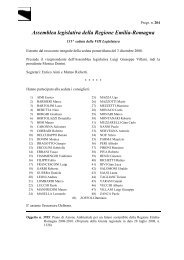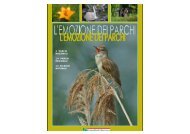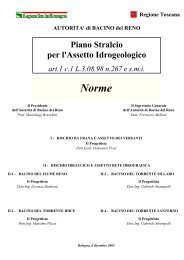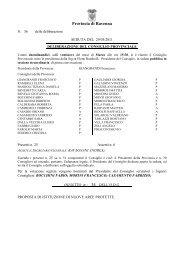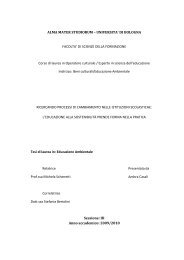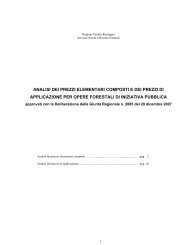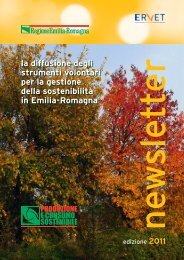air, water and soil quality qualité - ER Ambiente - Regione Emilia ...
air, water and soil quality qualité - ER Ambiente - Regione Emilia ...
air, water and soil quality qualité - ER Ambiente - Regione Emilia ...
You also want an ePaper? Increase the reach of your titles
YUMPU automatically turns print PDFs into web optimized ePapers that Google loves.
proportion of clayey material, as reported by Buscaroli et al. (2009). Compared to<br />
other data available from the area, referred to deeper <strong>and</strong> older sediments that include<br />
either fine or coarse grained sediments (Amorosi et al., 2002; Curzi et al.<br />
2006), Pb <strong>and</strong> Zn display wider ranges <strong>and</strong> highest maxima suggesting anthropogenic<br />
contribution for these elements. In the GP1 profile, the higher concentrations<br />
occur down to 25 cm depth, thus suggesting a diffuse migration of Pb <strong>and</strong> Zn elements<br />
to deeper horizon. All other elements, except for only one sample having<br />
high Cu concentration in P<strong>ER</strong>2 profile, are within the ranges observed for reference<br />
borehole data.<br />
Geoaccumulation index (Igeo) has been calculated for each metal (Table 2) in order<br />
to evaluate metals contamination in <strong>soil</strong> samples from the Ravenna area.<br />
Geoaccumulation index was originally defined by Müller (Müller, 1979; Forstner<br />
<strong>and</strong> Müller, 1981) as a quantitative tool to determine metals contamination in<br />
sediments <strong>and</strong> is based on the comparison of current concentrations with preindustrial<br />
levels. Geoaccumulation index (Igeo) can be calculated by the equation:<br />
Igeo = log2 [Cn/(1.5·Bn)] (1)<br />
where Cn = metal concentration in the the topmost sample; Bn = metal concentration<br />
in the 80-100 cm sample. In this way each site has a different background values<br />
but it helps because of the difference in grain size that affects EPT abundance.<br />
In any case the concentration in the deep samples are comparable with those of<br />
boreholes of analogous grain size as already pointed out.<br />
Müller has distinguished seven classes of sediments: unpolluted (Igeo 0), from<br />
unpolluted to moderately polluted (0 < Igeo < 1), moderately polluted (1 < Igeo < 2),<br />
from moderately to strongly polluted (2 < Igeo < 3), strongly polluted (3 < Igeo < 4),<br />
from strongly to extremely polluted (4 < Igeo < 5), extremely polluted (Igeo > 5).<br />
According to these scheme the Pb is most critical element suggesting moderately<br />
polluted conditions in the san Vitale pinewood in both transects with the <strong>soil</strong> profiles<br />
near to industrial settlement (PW1 <strong>and</strong> PW8) <strong>and</strong> for the Ravenna urban park.<br />
The most likely origin is related to emissions from vehicle exhaust that have been<br />
concentrated in these sites characterized by limited or absent reworking. There<br />
appears to be moderate pollution for copper in the P<strong>ER</strong>2 site, for the reasons already<br />
outlined.<br />
Table 2 – Values of the Igeo calculated according to Müller (1979). Only positive values<br />
were reported.<br />
Transect<br />
Soil<br />
profile Ba Cr<br />
Geoaccumulation index Igeo<br />
Cu Ni Pb V Zn<br />
PW-North<br />
PW1<br />
PW4<br />
0.6 1.9<br />
0.6<br />
0.5<br />
PW-South<br />
PW6<br />
PW8<br />
0.7<br />
2.0 0<br />
1.1<br />
0.7<br />
GP GP1 1.3 0.2<br />
P<strong>ER</strong> P<strong>ER</strong>2 1.4<br />
136



